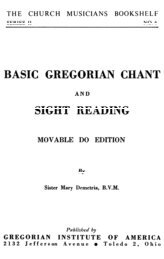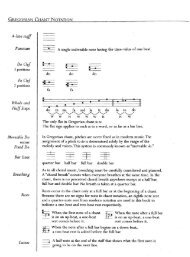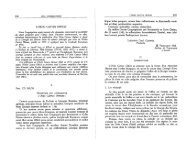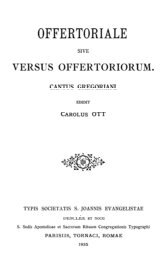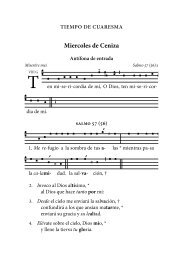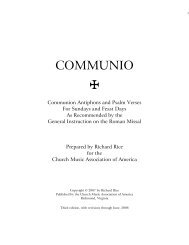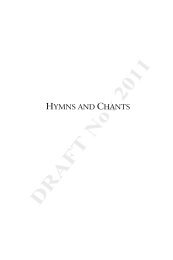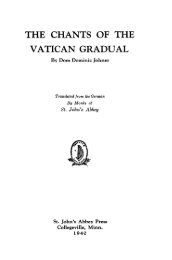William Byrd: A Celebration, edited by Richard Turget - MusicaSacra
William Byrd: A Celebration, edited by Richard Turget - MusicaSacra
William Byrd: A Celebration, edited by Richard Turget - MusicaSacra
You also want an ePaper? Increase the reach of your titles
YUMPU automatically turns print PDFs into web optimized ePapers that Google loves.
“Blame Not the Printer”: <strong>William</strong> <strong>Byrd</strong>’s Publishing Drive, 1588–1591 — 25<br />
right on the mark politically and socially with his commemorations of Sidney the great<br />
Protestant hero. <strong>Byrd</strong>’s reputation for skill as well as, in Peacham’s words, for gravity and piety,<br />
were greatly enhanced <strong>by</strong> the publication of his Latin songs, which only a few would see as subversive,<br />
and all would acknowledge as representing European high art—the highest language<br />
set forth in the most complicated polyphony. It is arguable that no English composer ever again<br />
was able to rise to such a challenge on such a scale.<br />
Yet in a sense this carefully constructed portrait of authority is undermined <strong>by</strong> the very<br />
expressiveness that for later generations gives it such power. The beauty of <strong>Byrd</strong>’s English music<br />
shows that there was no need for him to develop a sense of interiority. He could and possibly<br />
should have stayed within the carefully chosen world of the indigenous lyricist, adventuring<br />
into continental imitative polyphony only to create beautiful structures like the early works of<br />
Lassus.<br />
Interiority, a sense of inwardness: it comes into Tudor and Stuart culture through a variety<br />
of means. One is the growing awareness of the body and its humors according to the theories<br />
of Galenic medicine. Another is religious meditation, and it is here that we meet <strong>Byrd</strong>’s<br />
dilemma. I am proposing that the strength of his reaction to the persecution of his fellow<br />
Roman Catholics, and his identification with the Jesuit cause, drew him into modes of composition<br />
and expression that undermine his classical poise just as they make him intriguing for us<br />
today. It might be better to contemplate for a moment how dislocating all this must have been<br />
for a composer attracted on the one hand to the general, not particular, expressive values of<br />
medieval culture and on the other to strophic forms and abstract patterns (<strong>Byrd</strong> was equally an<br />
instrumental composer for all his protestations about the superiority of the voice). Looked at<br />
in this way, it is possible to assert that the crisis years, from the time his wife Julian and their<br />
servant John Reason were first cited for recusancy in 1577 until <strong>Byrd</strong> made the decision around<br />
1593 to retire to the Essex countryside, produced a very different composer from the one he set<br />
out to be.<br />
At Stondon Massey, close enough to the Petre establishment at Ingatestone, <strong>Byrd</strong> began a<br />
very different project, that of adorning the Roman Tridentine liturgy with art that was clearly<br />
meant to attain liturgical decorum as well as to promote the cause of the Jesuits and their<br />
Catholic Reformation. As I argue in the several prefaces to my edition of Gradualia, decorum<br />
was largely kept while more subtle ways were found to inject political messages into the printed<br />
volumes, through such means as musical nuance or arrangement of contents. 9 I spend some<br />
effort trying to contend with the theory that Joseph Kerman derived from the Catholic historian<br />
John Bossy that Gradualia and the Masses represent a Augustinian retreat into some sort<br />
of acceptance and acquiescence. But I would like to suggest that <strong>Byrd</strong> turned away from the<br />
continental expressive “motet,” though he imbued it with as much intensity as any of his peers,<br />
because it failed to satisfy some of his inbred aesthetic impulses and concerns. It had served as<br />
a catalyst, perhaps even in a cathartic manner, enabling him to process and produce his feelings<br />
in sometimes dramatic ways. But just as the keyboard pavan-galliard pair flowered because of<br />
their strophic limitations, and his grounds and other variations could build to expressive heights<br />
9 Reprinted in Philip Brett, <strong>William</strong> <strong>Byrd</strong> and His Contemporaries: Essays and a Monograph, ed. Joseph Kerman and<br />
Davitt Moroney (Berkeley: University of California Press, 2007), pp. 142, 143, 161.




